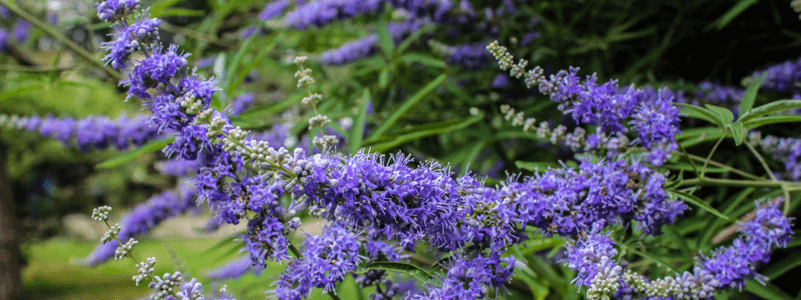Chasteberry, also known as Vitex agnus-castus, is a Mediterranean plant rich in the active compound agnuside, which supports female reproductive health by regulating the pituitary gland, alleviating menstrual symptoms like cramps, cravings, and mood swings, promoting breast health, and potentially aiding fertility and menopause management.
Chasteberry is a common name for Vitex agnus-castus, a species of flowering plant native to the Mediterranean region. It is also known by other common names such as Abraham’s Balm, Chaste Tree and Monk’s Pepper. Chasteberry has been known since antiquity and was described by the Greek botanist Theophrastus in the 4th century BC.
Chasteberry is widely cultivated in many tropical and sub-tropical regions throughout the world, primarily due to its value as foliage. The fruits and seeds of the chasteberry are also edible, usually as a subsistence food. It produces lavender flowers that grow in spikes and produce a delicate aroma that attracts butterflies. Chasteberry trees can grow to a height of more than 30 feet, especially in full sun and well-drained soil. They can grow as far north as Nantucket under ideal conditions.
Agnuside is one of the most significant active ingredients in chasteberry and is described chemically as an ester of p-hydroxybenzoic acid and aucubin. Agnuside’s greatest areas of benefit involve female reproductive cycles, which researchers believe is due to its effect on the pituitary gland. One study has also shown that extracts of chasteberry fruit bind to the opiate receptors in the brain, which would explain its use in relieving discomfort.
The relief of menstrual symptoms is the primary use of chasteberry as a nutritional supplement. Additional uses of this herb include support for reproductive and breast health.
Chasteberry may also help relieve periodic breast discomfort, especially those caused by the menstrual cycle. This type of chasteberry extract is typically combined with other herbs.
Chasteberry is often used to relieve menstrual symptoms, especially cramps, food cravings, and swelling. It may also help support bouts of anxiety, stress, and irritability.
Women who are trying to get pregnant may also take oral supplements of chasteberry extract. This regimen is typically followed for at least three months.
Some insect repellents are based on an extract of chasteberry seeds.

Irregularities in the menstrual cycle are one of the most common signs that you may benefit from chasteberry extracts. This includes conditions such as menopause, premenstrual syndrome (PMS), and premenstrual dysphoric disorder (PMDD), which is a more severe form of PMS. Additional signs that females may need chasteberry include low progesterone levels, poor reproductive health and function. Men who have a restricted flow of urine may also benefit from chasteberry.
Vitex agnus-castus, Abraham’s Balm, Chaste Tree and Monk’s Pepper
Shipping calculated at checkout
